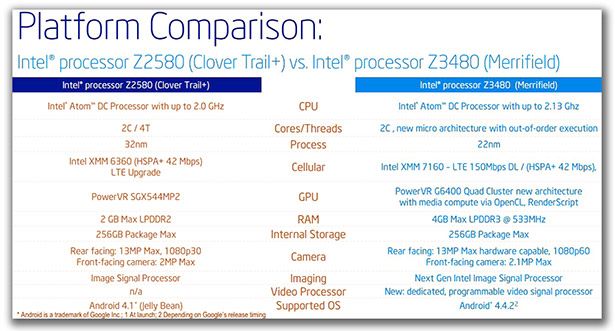Intel Debuts Merrifield and Moorefield Designs at MWC
Introduction
Intel is announcing its new tablet and smartphone designs this week at Mobile World Congress, alongside a major push to drive adoption of its 28nm XMM 7160 and XMM 7260 modem technology. It's been two years since Intel launched its first serious Atom-based smartphone platform, codenamed Medfield, and it's safe to say that those two years haven't gone precisely as Intel intended. Originally, the company planned to have a solid market share built up by now. Instead, it's planning a major tablet initiative with multiple partners with a few possible smartphone SoC wins on the side.
The chips that will power these efforts are the Z34 and Z35 families, known as Merrifield and Moorefield, respectively. A comparison of Merrifield and the older Clover Trail+ is shown below:
The new Merrifield core will use a 4G-capable XMM 7160 modem, a 1080p camera capable of 60 FPS capture, and the same Bay Trail CPU that we've previously reviewed. While it lacks Hyper-Threading, the additional of out-of-order processing means that the dual-core Bay Trail will be significantly faster than the older, in-order Atom parts.
Merrifield also uses a PowerVR GPU core based on Series 6 (codenamed "Rogue.") This new GPU core is substantially more powerful than the older cores Intel used in the past and contains four separate compute clusters. Historically, Intel's tablets and smartphones have targeted "acceptable" graphics rather than fielding anything genuinely first rate, but that may change in 2014.
The new Moorefield SoC is similar to Bay Trail in many respects. Maximum clock speeds are only slightly lower than Intel's Bay Trail, both chips support LPDDR3, and both are quad core designs. Where Moorefield differs from Bay Trail is that it includes the XMM 7160 modem (this chip isn't standard with a Bay Trail SoC) and it swaps out the Intel HD graphics architecture that Bay Trail uses for an expanded G6430 GPU from PowerVR. The G6430 GPU is similar to the G6400, but has more core resources and is designed to scale more effectively. RAM speeds are also lower than Bay Trail's, at a maximum of 800MHz as opposed to DDR3-1066.
The chips that will power these efforts are the Z34 and Z35 families, known as Merrifield and Moorefield, respectively. A comparison of Merrifield and the older Clover Trail+ is shown below:
The new Merrifield core will use a 4G-capable XMM 7160 modem, a 1080p camera capable of 60 FPS capture, and the same Bay Trail CPU that we've previously reviewed. While it lacks Hyper-Threading, the additional of out-of-order processing means that the dual-core Bay Trail will be significantly faster than the older, in-order Atom parts.
Merrifield also uses a PowerVR GPU core based on Series 6 (codenamed "Rogue.") This new GPU core is substantially more powerful than the older cores Intel used in the past and contains four separate compute clusters. Historically, Intel's tablets and smartphones have targeted "acceptable" graphics rather than fielding anything genuinely first rate, but that may change in 2014.
The new Moorefield SoC is similar to Bay Trail in many respects. Maximum clock speeds are only slightly lower than Intel's Bay Trail, both chips support LPDDR3, and both are quad core designs. Where Moorefield differs from Bay Trail is that it includes the XMM 7160 modem (this chip isn't standard with a Bay Trail SoC) and it swaps out the Intel HD graphics architecture that Bay Trail uses for an expanded G6430 GPU from PowerVR. The G6430 GPU is similar to the G6400, but has more core resources and is designed to scale more effectively. RAM speeds are also lower than Bay Trail's, at a maximum of 800MHz as opposed to DDR3-1066.









